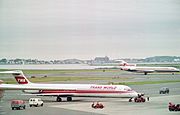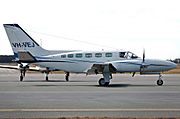TWA Flight 427 facts for kids
| Accident summary | |
|---|---|
| Date | November 22, 1994 |
| Summary | Runway incursion due to pilot error of the Cessna and ATC error |
| Place | St. Louis Lambert International Airport, Bridgeton, Missouri 38°44′29″N 90°20′46″W / 38.74139°N 90.34611°W |
| Total injuries (non-fatal) | 8 (minor) |
| Total fatalities | 2 |
| Total survivors | 140 |
| First aircraft | |
 N954U, seen at Logan International Airport, in August 1990 |
|
| Type | McDonnell Douglas MD-82 |
| Airline/user | Trans World Airlines |
| Registration | N954U |
| Flew from | St. Louis Lambert International Airport, Bridgeton, Missouri |
| Flying to | Stapleton International Airport, Denver, Colorado |
| Passengers | 132 |
| Crew | 8 |
| Injuries (non-fatal) | 8 (minor) |
| Fatalities | 0 |
| Survivors | 140 |
| Second aircraft | |
 A Cessna 441, similar to the aircraft involved in the accident |
|
| Type | Cessna 441 |
| Airline/user | Superior Aviation |
| Registration | N441KM |
| Flew from | Ford Airport, Iron Mountain, Michigan |
| Stopover | St. Louis Lambert International Airport, Bridgeton, Missouri |
| Flying to | Ford Airport, Iron Mountain, Michigan |
| Passengers | 1 |
| Crew | 1 |
| Fatalities | 2 |
| Survivors | 0 |
TWA Flight 427 was a regular passenger flight operated by TWA. On November 22, 1994, this flight was leaving St. Louis Lambert International Airport in Bridgeton, Missouri. The plane was a McDonnell Douglas MD-82. As it was taking off, it hit a smaller plane, a Cessna 441 Conquest II. Sadly, both people in the Cessna died in the accident.
Contents
Aircraft Involved in the Accident
TWA Flight 427 was flying from St. Louis International Airport to Stapleton International Airport in Denver, Colorado. The plane was a McDonnell Douglas MD-82, with the registration number N954U. There were 132 passengers and 8 crew members on board. The pilot was Captain Rick Carr, and the co-pilot was Randy Speed. Another crew member, Randy Richardson, was also in the cockpit.
The other plane involved was a Cessna 441 Conquest II, with the registration number N441KM. This Cessna was a charter plane. It had flown from Ford Airport in Iron Mountain, Michigan, to St. Louis. After dropping off a passenger, the Cessna was getting ready to fly back to Iron Mountain.
What Happened: The Accident
Flight 427 was supposed to leave St. Louis at 9:34 PM. It was about 15 minutes late. The flight crew was told to taxi to Runway 30R. At 10:01 PM, they told the air traffic controllers they were ready to take off from Runway 30R.
The Cessna had arrived earlier and dropped off its passenger. Around 9:58 PM, the Cessna pilot told ground control he was ready to taxi back to the runway. The ground controller told the Cessna to "back-taxi into position" and wait on Runway 31. "Back-taxiing" means using a runway to move in the opposite direction of planes taking off or landing, to get to the takeoff spot.
Even though the controller said Runway 31, the Cessna pilot did not repeat the runway number. Instead of going to Runway 31, the Cessna pilot taxied onto Runway 30R. This was the same runway Flight 427 was about to use for takeoff.
At 10:01:23 PM, Flight 427 was cleared to take off from Runway 30R. The MD-82 started speeding up at 10:02:27 PM. A few seconds later, the Cessna pilot told the controller he was "ready to go on the right side."
At 10:02:40 PM, the TWA pilot called out that they had reached 80 knots (about 92 miles per hour). Just a few seconds later, the crew saw the Cessna. Both pilots quickly hit the brakes. Captain Carr also turned the plane sharply to the left to try and avoid the Cessna.
About 2-3 seconds after seeing the Cessna, the TWA crew felt their plane hit it. They stopped their takeoff and brought the MD-82 to a halt on the left side of Runway 30R.
The right wing of the MD-82 hit the Cessna. It tore off parts of the Cessna's tail and the top of its cockpit. Both people in the Cessna died. The MD-82's cockpit and cabin were not damaged, and no one on board the TWA plane was killed.
Captain Carr immediately turned off the MD-82's engines and called for emergency help. He asked the control tower if there was a fire. The controller said he didn't see flames and added that the Cessna was not supposed to be on Runway 30R. Captain Carr replied, "All that later, I just want to make sure everything's safe here."
Because a lot of jet fuel had spilled, there was a risk of fire. Everyone on the TWA plane had to get off quickly. Eight passengers had minor injuries during the evacuation. The airport was not officially closed, and other planes continued to land and taxi nearby while passengers were getting off the damaged plane.
Investigating the Accident
The NTSB investigated the accident. They found that the Cessna pilot likely thought he would use Runway 30R, which he had used when he arrived. This might have made him less careful when the controller said Runway 31.
The airport's information system (ATIS) told pilots that runways 30L and 30R were being used. Runway 31 was also used for smaller planes, but this was not mentioned on the ATIS broadcast. The NTSB thought that if Runway 31 had been listed, the Cessna pilot might have paid more attention to the controller's instructions.
The NTSB also pointed out that the ground controller used unusual words and did not ask the Cessna pilot to repeat the runway number. This made it harder to know if the pilot understood correctly.
An NTSB spokesperson said that the TWA pilots helped prevent a much worse accident by turning their plane to the left before the crash.
Changes After the Accident
After the accident, the NTSB suggested that pilots should have to repeat runway assignments back to controllers. This way, controllers can check if the pilot understood correctly. The FAA changed its rules to require controllers to get confirmation from pilots about runway assignments. The NTSB believed that if this rule had been in place, the accident might not have happened.
The NTSB also suggested that the FAA should clearly define "back-taxi" so everyone uses the term the same way. They also recommended that ground radar be installed at the St. Louis airport. They repeated their suggestion that all airports should close immediately after any incident until the situation is clear.
The TWA plane, N954U, was repaired and continued to fly for TWA. Later, it was used by American Airlines after TWA stopped flying in 2001.
See also
 In Spanish: Vuelo 427 de TWA para niños
In Spanish: Vuelo 427 de TWA para niños

